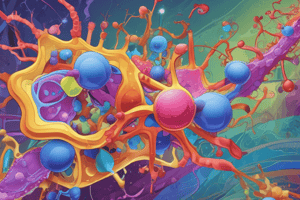Podcast
Questions and Answers
What is the primary role of HLA proteins in the immune response?
What is the primary role of HLA proteins in the immune response?
- To present antigens to T-cells (correct)
- To directly destroy pathogens
- To produce cytokines
- To generate lymphocyte receptors
Which cell types are primarily responsible for presenting antigens via HLA-2?
Which cell types are primarily responsible for presenting antigens via HLA-2?
- Cytotoxic T-cells
- All body cells
- Neutrophils and eosinophils
- B cells and macrophages (correct)
What distinguishes the type of antigens presented by HLA-1 and HLA-2?
What distinguishes the type of antigens presented by HLA-1 and HLA-2?
- HLA-1 and HLA-2 both present antigens from all types of pathogens equally.
- HLA-1 presents endogenous antigens, while HLA-2 presents exogenous antigens. (correct)
- Both HLA types present intracellular antigens exclusively.
- HLA-1 presents extracellular antigens, while HLA-2 presents intracellular antigens.
Which of the following statements about T-cell activation and HLA proteins is incorrect?
Which of the following statements about T-cell activation and HLA proteins is incorrect?
What is cross-presentation in the context of antigen presentation?
What is cross-presentation in the context of antigen presentation?
What is the primary source of antigenic peptides in the endogenous pathway?
What is the primary source of antigenic peptides in the endogenous pathway?
Which step occurs after the peptide is transported into the RER?
Which step occurs after the peptide is transported into the RER?
What type of proteins do immunoproteosomes process for HLA-1 presentation?
What type of proteins do immunoproteosomes process for HLA-1 presentation?
How are proteins targeted for degradation by proteasomes?
How are proteins targeted for degradation by proteasomes?
During what condition can HLA-1 proteins bind foreign peptides?
During what condition can HLA-1 proteins bind foreign peptides?
What is the role of IL-2 in lymphocyte activation?
What is the role of IL-2 in lymphocyte activation?
Which characteristic uniquely distinguishes Treg cells from other Th cells?
Which characteristic uniquely distinguishes Treg cells from other Th cells?
What distinguishes the cSMAC from the pSMAC during the APC-Th interaction?
What distinguishes the cSMAC from the pSMAC during the APC-Th interaction?
Which Th cell type is primarily associated with combating intracellular pathogens?
Which Th cell type is primarily associated with combating intracellular pathogens?
How does signal 2 help in the regulation of Th cells during their activation?
How does signal 2 help in the regulation of Th cells during their activation?
What key function do Th17 cells serve in the immune system?
What key function do Th17 cells serve in the immune system?
Which cytokines are essential for the polarization of naïve Th cells into Th17 cells?
Which cytokines are essential for the polarization of naïve Th cells into Th17 cells?
What is the role of ROR-γt in the polarization of Th17 cells?
What is the role of ROR-γt in the polarization of Th17 cells?
How do Th17 effector cells exert their major functions?
How do Th17 effector cells exert their major functions?
What distinguishes Th1 and Th17 cells in terms of their impact on antibody production?
What distinguishes Th1 and Th17 cells in terms of their impact on antibody production?
Which bacteria are commonly found in the nasal cavity as part of the normal microbiome?
Which bacteria are commonly found in the nasal cavity as part of the normal microbiome?
What type of bacteria is characterized as gram-negative and anaerobic, and includes lactate-fermenting species?
What type of bacteria is characterized as gram-negative and anaerobic, and includes lactate-fermenting species?
What is the primary role of Haemophilus spp. in the upper respiratory microbiome?
What is the primary role of Haemophilus spp. in the upper respiratory microbiome?
Which of the following statements about the microbiota of the upper and lower respiratory tracts is correct?
Which of the following statements about the microbiota of the upper and lower respiratory tracts is correct?
Which bacteria are identified as potent nitrate reducers in the normal microbiome of the pharynx and nasal cavity?
Which bacteria are identified as potent nitrate reducers in the normal microbiome of the pharynx and nasal cavity?
Which bacterium is identified as the causative agent of streptococcal pharyngitis?
Which bacterium is identified as the causative agent of streptococcal pharyngitis?
Which of the following is NOT a known virulence factor of Streptococcus pyogenes?
Which of the following is NOT a known virulence factor of Streptococcus pyogenes?
What is one of the primary benefits of the upper respiratory microbiome?
What is one of the primary benefits of the upper respiratory microbiome?
Which symptom is commonly associated with streptococcal pharyngitis?
Which symptom is commonly associated with streptococcal pharyngitis?
What type of hemolysis is characteristic of Streptococcus pyogenes?
What type of hemolysis is characteristic of Streptococcus pyogenes?
Flashcards are hidden until you start studying
Study Notes
Antigen Presentation Overview
- HLA (Human Leukocyte Antigen) complexes play critical roles in the immune system's recognition of antigens.
- HLA-1 is primarily involved in presenting intracellular antigens; HLA-2 presents extracellular antigens.
Learning Objectives
- Understand functions of HLA proteins in antigen presentation.
- Identify basic structures of HLA-1 and HLA-2.
- Recognize which cell types present antigens via HLA-1 and HLA-2.
- Describe endogenous (intracellular) and exogenous (extracellular) pathways for antigen processing.
- Distinguish between the types of antigens for each HLA type.
- Explore cross-presentation and identify capable cell types.
- Relate antigen presentation to T-cell activation and the necessary interactions for CD8+ (cytotoxic) and CD4+ (helper) T-cell activation.
Importance of HLA in T-cell Recognition
- T-cells require antigens to be presented in order to recognize and respond to them.
- Antigens are presented bound to HLA proteins on various cells, helping distinguish between foreign and self-antigens.
- MHC (Major Histocompatibility Complex) proteins in mice are analogous to HLA proteins in humans.
HLA-1 Expression and Function
- HLA-1 proteins bind primarily to intracellular antigens through the endogenous pathway.
- Endogenous antigens are often self-antigens; however, foreign peptides can occur during infection.
- Viral infections may lead to HLA-1 presenting both viral and host peptides.
HLA-1 Antigen Processing
- The source of antigenic peptides for HLA-1 is from the cytosol, often from proteasomal degradation of proteins.
- Peptides are transported to the Rough Endoplasmic Reticulum (RER) to bind with HLA-1 proteins before being expressed on the cell surface.
- Specialized proteasomes, termed immunoproteasomes, enhance peptide processing for HLA-1 presentation.
Regulation of HLA-1 Expression
- Intracellular invaders trigger an increase in HLA-1 protein transcription through NOD-like Receptors (NLRs), activating the NFκB pathway.
- Cytokines (e.g., Type 1 and Type 2 interferons, and TNFα) can upregulate HLA-1 expression following infection or cell activation.
T-cell Activation by HLA-1
- Peptide-bound HLA-1 on the cell surface engages CD8+ T-cells, leading to cytotoxic T-cell activation.
- Activated cytotoxic T-cells induce apoptosis in infected cells.
HLA-2 Expression
- HLA-2 binds extracellular antigens via the exogenous pathway, requiring the upregulation of HLA-2 protein.
- Interferon-gamma (IFN-γ) is a key cytokine that enhances HLA-2 expression, though it down-regulates HLA-2 in B-cells.
- IL-4 promotes HLA-2 expression specifically in B-cells.
HLA-2 Antigen Processing
- The exogenous pathway involves phagocytosis, where extracellular antigens are engulfed and processed within phagosomes before loading onto HLA-2 proteins.
- B-cell-mediated phagocytosis occurs through receptor-mediated endocytosis, allowing antibody-bound antigens to be processed in endosomes.
Summary of HLA Types
- HLA-1 and HLA-2 differ in the types of antigens they present, their pathways, and the specific T-cell types they activate.
- HLA-1 focuses on intracellular and endogenous pathways; HLA-2 addresses extracellular sources through exogenous pathways.
T-lymphocyte Biology Objectives
- Understand the activation process of helper T cells (Th) and T-lymphocyte class restriction.
- Compare the roles and locations of costimulator, co-receptor, and adhesion molecules during APC-Th interaction, emphasizing cSMAC vs. pSMAC.
- Define the function of interleukin-2 (IL-2) in lymphocyte activation and its release mechanism.
- Differentiate the activation signals, polarizing cytokines, transcription factors, effector cytokines, and immune response contributions of Th1, Th2, Th17, Tfh, and Treg cells.
- Recognize the unique characteristics of Treg and Tfh cells compared to other Th cells.
- Describe cross-regulation among Th cells and the underlying mechanisms.
- Detail CD8+ cytotoxic T-cell activation, antigen recognition, and foreign cell destruction.
T-cell Activation
- All CD8+ T cells are Class I MHC-restricted, while all CD4+ T cells are Class II MHC-restricted.
- Signal 1 involves the T-cell receptor (TCR) interacting with MHC-II (HLA-2) and CD4 co-receptor presence.
- Signal 1b indicates rare conversion of Th1 cells to Th2, with Tfh cells potentially undergoing re-polarization after antibody response completion.
- Cross-regulation is when polarized Th cells generate signals that inhibit polarization of local Th cells into different types.
Th17 - Innate Activating T Cells
- Th17 cells identified recently, primarily engaged in defense against bacterial and fungal infections, and implicated in several autoimmune conditions (e.g. rheumatoid arthritis, MS).
- Th17 polarization occurs in secondary lymphoid organs (SLOs) via pro-inflammatory cytokines (IL-6, IL-23) and TGF-β.
- Activated Th17 cells secrete IL-22 and IL-17, promoting recruitment of neutrophils/macrophages and antimicrobial protein secretion in inflamed tissues.
- ROR-γt is the critical transcription factor driving Th17 polarization, inhibiting secretion of other cytokines.
Follicular Th Cells - Key Role in Antibody Production
- Tfh cells remain in SLOs, promoting B-cell development and germinal center formation.
- Facilitate two rounds of antibody production: initial lower-affinity and subsequent higher-affinity antibodies through affinity maturation.
- Lack of Tfh activity results in reduced B-cell functionality and antibody refinement.
T-regulatory Cells
- T-regulatory cells (Tregs) down-regulate other immune cell activities, particularly in anti-inflammatory environments driven by TGF-β.
- TGF-β acts as the polarizing cytokine with minimal inflammatory cytokines present.
- FoxP3 is the essential transcription factor for Treg differentiation.
- Effector functions include anti-inflammatory cytokine secretion (IL-10, TGF-β), down-regulation of CD80/CD86 signaling via CTLA-4 binding, and IL-2 consumption from other effector T-cells.
Cross-Regulation Among Th Cells
- Expression of the determining transcription factor signals polarization of naive Th cells.
- Each Th type’s transcription factor prevents production of alternative transcription factors and cytokines.
- Cytokines produced by one Th type can inhibit survival and proliferation of other Th types.
Upper Respiratory Tract Microbiology
- Upper respiratory system hosts a diverse microbiome, unlike the lower respiratory system, which is free of resident microbiota.
- Key microorganisms in the upper respiratory tract include:
- Nose: Haemophilus, Veillonella, diphtheroids
- Nasal Cavity: Staphylococcus, diphtheroids
- Pharynx: Staphylococcus, Streptococcus, diphtheroids
Normal Microbiome Components
- Haemophilus spp.: Requires X Factor (Hemin) and V Factor (NAD+) for growth; notable species includes H. influenzae.
- Veillonella spp.: Gram-negative, anaerobic bacteria; effective lactate fermenters and nitrate reducers; example species is V. parvula.
- Staphylococcus spp.: Staphylococcus aureus is a major pathogen linked to pneumonia, meningitis, toxic shock syndrome, and more.
- Diphtheroids: Include Corynebacterium diptheriae and Propionibacterium acnes.
- Alpha-hemolytic Streptococci: Capable of varying levels of hemolysis; includes Streptococcus pneumoniae and Streptococcus pyogenes.
Microbiome Benefits and Risks
- Positive Aspects: The microbiome limits the potential for infections.
- Negative Aspects: Opportunistic pathogens can become problematic under certain conditions.
Bacterial Pharyngitis Overview
- Commonly referred to as "strep throat," characterized by painful swallowing, bad breath, fever, malaise, and headache.
Causative Agent
- Streptococcus pyogenes:
- Gram-positive, facultative anaerobe; Lancefield Group A Streptococcus; exhibits beta-hemolytic activity.
Virulence Factors of Streptococcus pyogenes
- M protein inhibits C3b activity, aiding in evasion of the immune response.
- Possesses a hyaluronic acid capsule for protection.
- Produces enzymes like streptokinases and C5a peptidase to enhance pathogenicity.
- Can secrete pyrogenic toxins and streptolysin O, contributing to its infectious potential.
Epidemiology of Streptococcal Pharyngitis
- Understanding of epidemiology links to transmission patterns, risk factors, and demographic considerations, although specific details were not provided.
Studying That Suits You
Use AI to generate personalized quizzes and flashcards to suit your learning preferences.




